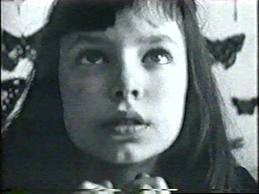PSYCHOMANIA (1972)
 In SCREAM AND SCREAM AGAIN, two hikers out on the moors are being shot at by Nazi-like soldiers. The female ambler is played by a pre-LUST FOR A VAMPIRE Yutte Stensgaard, who is subsequently taken to a castle for torture.
In SCREAM AND SCREAM AGAIN, two hikers out on the moors are being shot at by Nazi-like soldiers. The female ambler is played by a pre-LUST FOR A VAMPIRE Yutte Stensgaard, who is subsequently taken to a castle for torture.BOTH these pictures come from a period in British horror where more outlandish themes were being explored rather than the increasingly dated Hammer Gothics. Gordon Hessler's SCREAM AND SCREAM AGAIN is a conspiracy thriller like no other, an AIP/Amicus co-production that features a delirious mix of body parts, gallows humour and police pursuits. With the major draw of Vincent Price, Christopher Lee and Peter Cushing, the film basically is another take on the Frankenstein legend. Opening with a runner collapsing in a London park and finding himself waking in a strange hospital where he's missing a leg, the story weaves its way through three main plot threads: rogue general Konratz (Marshall Jones) murdering his way into power of an unnamed Eastern bloc country; serial vampire rapist Keith (Michael Gothard) preying on young women he picks up in 'happening' nightclubs; and Dr Browning (Vincent Price)'s Composite programme, a plan to infest the world with controllable beings of organic and synthetic tissue.
Based on the 1966 SF novel The Disorientated Man by "Peter Saxon" - in reality a pen name used by W.Howard Baker and Stephen Frances - the film rights were picked up by Milton Subotsky, who turned in his usual old-fashioned treatment which was re-written by Christopher Wicking. The resulting screenplay is remarkably faithful to the book, apart from dropping an alien explanation for a paranoid political message. Price fares best of the top-billed stars, with Lee and Cushing given disposable roles: the former as a government official and the latter as a very disposable military superior. However it is Gothard and Alfred Marks - who apparently ad-libbed much of his dialogue as Inspector Bellaver - who give the most memorable performances. Marks shines in the grand pantheon of disgruntled police inspectors that populate British horror, and in a part described by Jonathan Rigby in English Gothic: a Century of Horror Cinema as resembling "a bionic Mick Jagger", Gothard carries out a very unpleasant alley attack and later there is a celebrated car chase sequence. Its all infectiously ridiculous, capped by a maniacal climactic battle between Browning and Konratz, filled with a vulcan-like shoulder squeeze and hearty swings of a gas cylinder.
John Cameron's score is the highlight of PSYCHOMANIA, essentially a rock soundtrack that achieves the gravitas of a sweeping orchestra.
Don Sharp's PSYCHOMANIA tells of Tom Latham (Nicky Henson), the leader of The Living Dead motorcycle gang, who terrorise the Home Counties and hang around standing stones called The Seven Witches. Tom's mother (Beryl Reid) is a medium aided by butler Shadwell (George Sanders), and there is a mystery surrounding the death of Mr Latham ("why did my father die in that locked room? Why do you never get any older? And what is the secret of the living dead?") When Tom achieves "the ton," he crashes off a bridge and dies; the gang bury him upright on his bike, and he comes back to life a couple of days later, terrorising the local populace and convincing his gang members that in order to come back from the dead you only have to believe you will. Only Tom’s girlfriend Abby (Mary Larkin) refuses.
PSYCHOMANIA's incoherent and kitsch charm mixes the trademark tranquil eccentricity of British horror with Frog cults and zombie bikers, becoming a metaphor for teen rebellion and anger at the establishment (all the members of The Living Dead want to do is cause trouble and "blow some squares’ minds"). The film was almost universally blasted by critics on release - The Times wrote that PSYCHOMANIA was only fit to be shown at an "SS reunion party" - but today this Benmar production is a guilty pleasure. Like Tom's early exchange with Shadwell, there are more questions than answers: what actually occurred at Tom's birth?; what is the history of the magic room?; who is Shadwell servant to?; and did Mrs Latham's powers turn seven witches into the standing stones? Henson is the lifeblood, but Sanders' bizarre presence has the distinction of seemingly being the film that drove the actor to suicide. Leaving behind an aptly Wildesque note, Sanders wrote "Dear World, I am leaving because I am bored. I feel I have lived long enough. I am leaving you with your worries in this sweet cesspool. Good luck."













.jpg)
















